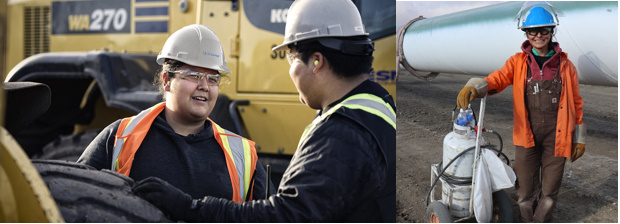-
Module 2.0 How to be Successful in this Course
-
Module 2.1 Introduction to Natural Gas
-
Module 2.2 The Natural Gas Industry in British Columbia
- Overview
- Learning Outcomes
- Natural Gas Science – The Simple Version
- Natural Gas Science – Chemistry
- Natural Gas Science – Physics
- Natural Gas Science – Units of Measurement
- Natural Gas Science – Geology
- Natural Gas Resources and Uses
- Oversight of the Natural Gas Industry
- Understanding Land Rights and Natural Gas
- Energy and the Future
-
Module 2.3 Upstream – Well Site Selection, Preparation and Drilling, Completion, Production, Water Recycling, and Reclamation
- Learning Outcomes
- The Upstream Sector – Extraction and Processing
- The Upstream Sector – Exploration and Site Selection
- The Upstream Sector – Preparation and Drilling
- The Upstream Sector – Completion
- The Upstream Sector – Production
- The Upstream Sector – Water Recycling
- The Upstream Sector – Reclamation
- Upstream Companies and Jobs in British Columbia – Companies
- Upstream Companies and Jobs in British Columbia – Industry Associations
- Upstream Companies and Jobs in British Columbia – Professional Associations
- New Vocabulary
-
Module 2.4 Midstream – Transportation, Processing, Refining
- Learning Outcomes
- The Midstream Sector
- The Midstream Sector – Processing Natural Gas
- The Midstream Sector – Liquefied Natural Gas
- The Midstream Sector – An Emerging Industry
- The Midstream Sector – Processing LNG
- The Midstream Sector – Proposed LNG Projects in British Columbia
- Transportation
- Midstream Companies and Jobs in British Columbia
-
Module 2.5 Downstream – Refining and Markets
-
Module 2.6 Health and Wellness in the Natural Gas Industry
-
Module 2.7 Safety
-
Module 2.8 Terminology and Communication
-
Module 2.9 Jobs and Careers
- Learning Outcomes
- Industry Outlook
- Technology is Changing Workforce and Skills
- Employment in the Natural Gas Industry
- Employment in the Natural Gas Industry – Types of Employment
- Employment in the Natural Gas Industry – Range of Jobs
- Employment in the Natural Gas Industry – High Demand Jobs and Occupations
- Occupational Education and Training
-
Module 3.0 How to be a Valued Employee
-
Module 3.1 Identifying Interests and Skills
-
Module 3.2 Looking for Employment in Natural Gas
-
Module 3.3 Applying for Employment in Natural Gas
Companies
Below is a sample list of companies which operate in the midstream natural gas sector in British Columbia.
- Arc Resources
https://www.arcresources.com/ - Ovintiv
https://www.ovintiv.com/ - Petronas
https://www.petronascanada.com/ - Shell
https://www.shell.ca/ - Tourmaline Oil
https://www.tourmalineoil.com/ - North River Midstream
https://www.nrm.ca/energy-done-differently/ - Keyera
https://www.keyera.com/titanweb/keyera/webcms.nsf/0/4209C38B07A9CF1787257AAD006FE160?opendocument - Veresen Midstream
https://veresenmidstream.com/ - TC Energy
https://www.tcenergy.com/ - Enbridge
https://www.enbridge.com/ - Alliance Pipeline
https://www.alliancepipeline.com/Pages/default.aspx - Pembina Pipeline
http://www.pembina.com/ - FortisBC
https://www.fortisbc.com/”
To find additional companies, go back to Module 2.3 and review the company lists shown on websites of the major industry associations.The websites provide a very comprehensive listing of small, medium, and large companies operating in the oil and natural gas industries in British Columbia and across Canada. Use these sites to identify midstream companies that you are interested in working for.
Occupations and Jobs
The midstream sector offers jobs in a range of occupational areas. Some examples are listed below. Also see Module 2.9 for more information on careers in these occupations.
- Process Operation (Petroleum, Gas, Chemical, Pipeline) e.g., Gas Plant Operators, Power Engineers
- Transportation e.g., Truck Drivers, Marine Workers, Pilots
- Skilled Trades e.g., Millwrights, Electricians, Instrumentation Technicians, Welders
- Engineering and Technology e.g., Petroleum, Chemical, Mechanical and Industrial Engineers, Technicians, and Technologists
- Health and Safety e.g., Coordinators, Trainers
- Sales and Marketing
- Communications e.g. Indigenous Consultation, Stakeholder Engagement, and Government Relations
- Environment
- Human Resources
- Contracting, Procurement and Warehousing
LNG Jobs
As the liquefied natural gas (LNG) sector develops and grows, it will create both short- and long-term jobs. Short term (or temporary) jobs will be created during the construction phase jobs related to building liquefied natural gas (LNG) plants, pipelines and transportation infrastructure as well as jobs supplying goods and services to companies and workers involved in the construction phase. Jobs in the construction phase are primarily in the construction trades carpenters, electricians, instrumentation, millwrights, pipe fitters, welders, etc.

Long term (or permanent jobs) are created once the new liquefied natural gas (LNG) plants are operational. While there will not be as many operations and maintenance jobs, these jobs will last for several decades until LNG operations are no longer commercial or natural gas resources are no longer available or in demand.
Indirectly, growth and the new liquefied natural gas (LNG) sector will support thousands of spin-off jobs in the fields of transportation, engineering, construction, and environmental management.
BC Provincial Government Job Estimates
Based on previous provincial estimates that the LNG sector could create more than 39,000 annual jobs over a nine-year construction period and approximately 75,000 jobs once the plants are fully operational. The estimates are based on three plants being built and operational by 2020. Jobs include direct and indirect employment during the construction phase as well as long-term operations.

Direct employment refers to jobs directed related to making or producing goods or services. Indirect employment refers to jobs which support the processes of making the goods and services. In the natural gas industry, there are far more indirect than direct jobs. Maintenance electrician and compressor plant operator are examples of direct jobs; while truck drivers, land surveyor, environmental consultant, and supplier warehouse personnel are examples of indirect jobs.

Video 7: LNG Workforce (02 minutes 38 seconds)
For additional information on LNG, visit:

Website 3: Workforce Development
https://www.lngcanada.ca/opportunities/workforce-development/
Video 8: Natural Gas in BC (02 minutes 38 seconds)
![]()
Learning Activity 5: Mad-Minute Midstream Learning
In Learning Activities 1 and 2, you looked at the knowledge you had about the midstream sector of the natural gas industry before you read all the information in the module. Now it is your turn to show what you have learned.
Instructions
- Choose an aspect about the midstream sector that you did not know about before but do now.
- What surprised you most?
- Write down a few thoughts about what you learned
- Share your new knowledge in a mad minute a mad minute means you only have one minute to tell what you know
Communities and LNG Projects
Liquefied natural gas (LNG) projects like the ones listed in the Table 1 will mean changes for a number of communities in northern British Columbia (e.g. Prince Rupert, Kitimat, Stewart), as well as in the Lower Mainland (e.g. Delta, Squamish) and Vancouver Island (e.g. Sarita Bay). The industry is working collaboratively with these communities, Indigenous peoples and local and regional governments to prepare for the coming development and find sustainable solutions for things like housing and skills training for workers, in a way that preserves and respects the unique culture and beauty of these important regions.
Video 9 highlights some of the activities underway with LNG Canada and the Haisla Nation.
Video 9: LNG Canada and the Haisla Nation – Working Towards Economic Growth (03 minutes, 50 seconds)
Learning Activity 6: Living in a Natural Gas or LNG Community in BC
This learning activity will help you get a feel for what it might be like to live in or near a community where natural gas is processed and/or where LNG plants are proposed.
Instructions
- Use information from Table 1 and Websites 1 and 2 to research communities in British Columbia close to natural gas and LNG operations or projects.
- Select a community and describe what life would be like in the community for a family moving there from a large city within or outside of the province.The family consists of two parents (both of whom work outside the home) and two school-aged children (one in elementary school and one in high school). One parent has a natural gas/LNG related job; the other parent needs to find a job.
- Where and what type of home might they have?
- Are there schools for the children, and if so, where are they?
- What kind of leisure activities are possible?
- What community services are available e.g., medical, sports, recreation, etc.?
- What is the housing availability and affordability?
- Share your findings as a class.
Suggested Reading
- Our Petroleum Challenge – Sustainability into the 21st Century, Eighth Edition, Online PDF: Canadian Centre for Energy Information
- Section 2 – Inside the Industry
- Chapter 5 Transportation. pages 70-81
- Chapter 7 Marketing. pages 88-91
- Section 2 – Inside the Industry
- BC LNG Alliance
https://canadianlnga.ca/ - Oil and Gas Glossary and Definitions, Version 1.11: February 2019\
documentation-glossary-v111-feb-release-2019 - NaturalGas.org Processing Natural Gas
http://naturalgas.org/naturalgas/processing-ng/ - American Gas Association, How Does the Natural Gas Delivery System Work?
https://www.aga.org/natural-gas/delivery/how-does-the-natural-gas-delivery-system-work-/
